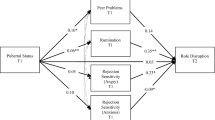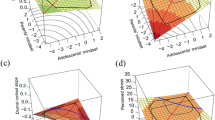Abstract
Individuation, a process whereby adolescents gain autonomy from their parents while maintaining emotional relatedness, is displayed by characteristic styles of verbal exchanges. Negotiating this developmental transition is often stressful for adolescents and their parents. This study deals with the association between pubertal timing, communication behaviors, and stress reactivity assessed during young females’ conflict discussions with their mothers. A sample of N = 32 girls (age 9–13, T1) was grouped by pubertal timing. Years later (age 17–22, T2) they were followed up and videotapes of daughter–mother conflict discussions were evaluated. Salivary alpha-amylase was used to assess the stress reactivity. Results revealed that young women who had entered puberty early were higher in striving for control and separation in interactions with their mothers, and displayed higher stress levels. These results pointed to less successful individuation in late adolescence/young adulthood compared to on-time and late maturing age mates.
Similar content being viewed by others
Notes
Additional analyses revealed only weak and non-significant correlations between communication behaviors and change in A-A of the daughters during the conflict discussion with their mothers (i.e., Confidence in Stating Opinion r = −.06, Rejection r = −.16, Power r = .21, Suggesting Input r = .25, Attempting Resolutions r = −.03, Warmth r = −.06, and Receptiveness r = .16). This suggests that a rather general stress reaction induced by the conflict discussion with the mother is captured by A-A. This stress may be caused by earlier experiences within the family system (e.g., high behavioral control of the parents) triggered within the communication situation.
References
Alsaker, F. D. (1992). Pubertal timing, overweight, and psychological adjustment. Journal of Early Adolescence, 12(4), 396–419.
Bortz, J. (2005). Statistik für Human- und Sozialwissenschaftler [Statistics for human and social sciences]. Berlin: Springer.
Bosma, H., Jackson, S., Zijsling, D., Zani, B., Ciogniani, E., Xerri, L., Honess, T., & Charman, L. (1996). Who has the final say? Decisions on adolescent behavior within the family. Journal of Adolescence, 19, 277–291.
Büttig, S., Weichold, K., & Silbereisen, R. K. (2007). Folgen von Unterschieden im pubertären Timing bei Mädchen in der späten Adoleszenz [Pubertal timing in girls and consequences in late adolescence]. Zeitschrift für Entwicklungspsychologie und Pädagogische Psychologie, 39(3), 111–119.
Chatterton, R. T. J., Vogelsong, K. M., Lu, Y. C., Ellman, A. B., & Hudgens, G. A. (1996). Salivary alpha-amylase as a measure of endogenous adrenergic activity. Clinical Physiology, 16, 433–448.
Chorous, G. P., & Gold, P. W. (1992). The concepts of stress and stress system disorders. Overview of physical and behavioral homeostasis. Journal of the American Medical Association, 267(9), 1244–1252.
Coakley, R. M., Holmbeck, G. N., Friedman, G. N., Greenley, R. N., & Thill, A. W. (2002). A longitudinal study of pubertal timing, parent-child conflict, and cohesion in families of young children with spina bifida. Journal of Pediatric Psychology, 27(5), 461–473.
Cohen, J. (1968). Weighted kappa: Nominal scale agreement provision for scaled disagreement or partial credit. Psychological Bulletin, 70(4), 213–220.
Cohen, J. (1988). Statistical power analysis for the behavioral sciences. Hillsdale: Lawrence Erlbaum.
Decovic, M., Noom, M. J., & Meeus, W. (1997). Expectations regarding development during adolescence: Parental and adolescent perceptions. Journal of Youth and Adolescence, 26(3), 253–272.
Dorn, L. D., Dahl, R. E., Woodward, H. R., & Biro, F. (2006). Defining the boundaries of early adolescence: A user’s guide to assessing pubertal status and pubertal timing in research with adolescents. Applied Developmental Science, 10(1), 30–56.
Dubas, J. S., & Petersen, A. C. (1993). Female pubertal development. In M. Sugar (Ed.), Female adolescent development. New York: Brunner/Mazel.
Graber, J. A., Lewinsohn, P. M., Seeley, J. R., & Brooks-Gunn, J. (1997). Is psychopathology associated with the timing of pubertal development? Journal of the American Academy of Child and Adolescent Psychiatry, 36(12), 1768–1776.
Graber, J. A., Seeley, J. R., Brooks-Gunn, J., & Lewinsohn, P. M. (2004). Is pubertal timing associated with psychopathology in young adulthood? Journal of the American Academy of Child and Adolescent Psychiatry, 43(6), 718–726.
Granger, D. A., Kivlighan, K. T., Blair, C., El-Sheikh, M., Mize, J., Lisonbee, J. A., Buckhalt, J. A., Stroud, L. R., Handwerger, K., & Schwartz, E. B. (2006). Integrating the measurement of salivary α-amylase into studies of child health, development, and social relationships. Journal of Social and Personal Relationships, 23(2), 267–290.
Grotevant, H. D., & Cooper, C. R. (1985). Patterns of interaction in family relationships and the development of identity explorations in adolescence. Child Development, 56, 415–428.
Güre, A., Uçanok, Z., & Sayil, M. (2006). The association among perceived pubertal timing, parental relations and self-perception in Turkish adolescents. Journal of Youth and Adolescence, 34(4), 541–550.
Hakim-Larson, J., & Hobart, C. J. (1987). Maternal regulation and adolescent autonomy: Mother-daughter resolution of story conflicts. Journal of Youth and Adolescence, 16, 153–166.
Hauser, S. T., Liebmann, W., Houlihan, J., Powers, S. I., Jacobson, A. M., Noam, G. G., Weiss, B., & Follansbee, D. (1985). Family contexts of pubertal timing. Journal of Youth and Adolescence, 14(4), 317–337.
Hill, J. P., & Holmbeck, G. N. (1987). Familial adaptation to biological change during adolescence. In R. M. Lerner et al. (Eds.), Biological-psychosocial interactions in early adolescence. Child psychology (pp. 207–223). Hillsdale: Erlbaum.
Hofer, M., Pikowsky, B., Fleischmann, T., & Spranz-Forgasy, T. (1993). Argumentationssequenzen in Konfliktgesprächen [Sequences of argumentation during conflict discussions]. Zeitschrift für Sozialpsychologie, 24, 15–24.
Hofer, M., & Sassenberg, K. (1997). Relationship and family discourse in different situations. In M. Hofer, J. Youniss, & P. Noack (Eds.), Verbal interaction and development in families with adolescents. Ablex: New York.
Holmbeck, G. N., Belvedere, M., Gorey-Ferguson, L., & Schneider, J. (1995). Family macro-coding manual—March of Dimes triadic version. Chicago: Loyola University.
Holmbeck, G. N., & Hill, J. P. (1991). Conflictive engagement, positive affect, and menarche in families with seventh-grade girls. Child Development, 62(5), 1030–1048.
Kirschbaum, C. (1991). Cortisolmessung im Speichel – Eine Methode der Biologischen Psychologie [Cortisol measurement in saliva – A method of biological psychology]. Bern: Hans Huber.
Laursen, B., & Collins, W. A. (1994). Interpersonal conflict during adolescence. Psychological Bulletin, 115, 197–209.
Montemayor, R., Eberly, M., & Flannery, D. J. (1993). Effects of pubertal status and conversation topic on parent and adolescent affective response. Journal of Early Adolescence, 13, 431–447.
Nater, U. M., Marca, R., Florin, L., Moses, A., Langhans, W., Koller, M. M., & Ehlert, U. (2006). Stress-induced changes in human salivary alpha-amylase activity-associations with adrenergic activity. Psychoneuroendocrinology, 31, 49–59.
Nater, U. M., Rohleder, N., Gaab, J., Berger, S., Jud, A., Kirschbaum, C., & Ehlert, U. (2005). Human salivary alpha-amylase reactivity in a psychosocial stress paradigm. International Journal of Psychophysiology, 55, 333–342.
Norusius, M. J. (1993). SPSS for windows: Base user’s guide, release 6.0. SPSS Inc.
Paikoff, R. L., & Brooks-Gunn, J. (1992). Do parent-child relationships change during puberty? Psychological Bulletin, 110, 47–66.
Petersen, A. C., Crockett, L., Richards, M., & Boxer, A. (1988). A self-report measure of pubertal status: Reliability, validity, and initial norms. Journal of Youth and Adolescence, 17(2), 117–133.
Pinquart, M., & Silbereisen, R. K. (1999). Observed conflict between German mothers and adolescents: Correlates and change. Paper presented at the Biennal Meeting of the Society for Research on Child Development at Albuquerque, April, 15–18, 1999.
Reis, O., Eisermann, J., & Meyer-Probst, B. (2003). Soziale Verbundenheit im frühen Erwachsenenalter – Muster und Antezedenzien. [Social relatedness during early adulthood – Patterns and antecedents]. Zeitschrift für Familienforschung, 3, 125–142.
Ruiselová, Z. (1998). Relationships with parents and teachers in connection with pubertal maturation timing in girls. Studia Psychologica, 40(4), 277–281.
Sagrestano, L. M., McCormock, S. H., Paikoff, R. L., & Holmbeck, G. H. (1999). Pubertal development and parent-child conflict in low-income, urban, African American adolescents. Journal of Research on Adolescents, 9(1), 85–107.
Savin-Williams, R. C., & Small, S. A. (1986). The timing of puberty and its relationship to adolescent and parent perceptions of family interactions. Developmental Psychology, 22(3), 342–347.
Silbereisen, R. K., & Kracke, B. (1997). Self-reported maturational timing and adaptation in adolescence. In J. Schulenberg, J. L. Maggs, & K. Hurrelman (Eds.), Health risks and developmental transitions during adolescence (pp. 85–109). Cambridge: Cambridge University Press.
Silbereisen, R. K., Kracke, B., & Nowak, M. (1992). Körperliches Entwicklungstempo und jugendtypische Übergänge [Pubertal timing and transitions during adolescence]. In J. Zinnecker (Ed.), Jugend ’92: Lebenslagen, Orientierungen und Entwicklungsperspektiven im vereinigten Deutschland, Bd. 2 Im Spiegel der Wissenschaften (pp. 171–196). Opladen: Leske & Budrich.
Silbereisen, R. K., & Schmitt-Rodermund, E. (1996). “Entwicklungsfahrpläne” – Jugendliche in Deutschland unterscheiden sich im Tempo des Erwachsenwerdens [“Developmental time tables” – Adolescents in Germany differ regarding their timing of becoming an adult]. In P. Dillig & H. Schilling (Eds.), Erziehungsberatung in der Postmoderne (pp. 71–83). Mainz: Matthias-Gruenewald-Verlag.
Silbereisen, R. K., & Schwarz, B. (1998). Körperliche Entwicklung [Physical development]. In J. Zinnecker & R. K. Silbereisen (Eds.), Kindheit in Deutschland (pp. 147–157). Weinheim: Juventa Verlag.
Silverberg, S. B., & Steinberg, L. (1990). Psychological well-being of parents with early adolescent children. Developmental Psychology, 26(4), 658–666.
Srugies, D. (1997). Adaptation und Evaluation eines Kodiersystems zur Beobachtung von Interaktionen zwischen Jugendlichen und ihren Müttern [Adaptation and evaluation of a coding manual for observations of mother-adolescent interactions]. Jena: Friedrich-Schiller-University.
Stattin, H., & Magnusson, D. (1990). Pubertal maturation in female development. Hillsdale: Lawrence Erlbaum.
Stegeren, A., Rohleder, N., Everaerd, W., & Wolf, O. T. (2006). Salivary alpha amylase as marker for adrenergic activity during stress: Effect of betablockade. Psychoneuroendocrinoloy, 31, 137–141.
Steinberg, L. (1988). Reciprocal relation between parent-child distance and pubertal maturation. Developmental Psychology, 24(1), 122–128.
Steinberg, L. (2001). We know some things: Parent-adolescent relationships in retrospect and prospect. Journal of Research on Adolescence, 11(1), 1–19.
Susman, E. J. (2007). Puberty revised: Mechanism and the future. Paper presented at the Biennial Meeting of the Society for Research on Adolescence, March 29–April 1, 2007, Boston, USA.
Walper, S. (1997). Individuation im Jugendalter – Skalen-Analysen zum Münchner Individuationstest [Individuation during adolescence – Scala analyses of the Munich individuation test]. Munich: Ludwig-Maximilian-University.
Weichold, K., & Silbereisen, R. K. (2000). Links between timing of puberty and behavioral indicators of individuation. Paper presented at the 8th Biennial Meeting of the Society for Research on Adolescence, March 30–April 2, 2000, Chicago, USA.
Weichold, K., Silbereisen, R. K., & Schmitt-Rodermund, E. (2003). Short-term and long-term consequences of early versus late physical maturation in adolescents. In C. Hayward (Ed.), Gender differences at puberty (pp. 241–276). Cambridge: Cambridge University Press.
Youniss, J., & Smollar, J. (1985). Adolescent relations with mothers, fathers, and friends. Chicago: University of Chicago Press.
Acknowledgements
This study was financially supported by the Ministry of Science, Research and Culture of the Federal State of Thuringia, Germany (P.I.: Rainer K. Silbereisen & Wolfgang M. Miltner: “Biopsychosocial Mechanisms of the Development of Problem Behavior in Girls during Puberty and Adolescence”, B301 96060), and the Center for Applied Developmental Science (CADS; Director: Rainer K. Silbereisen) at the University of Jena, Germany.
Author information
Authors and Affiliations
Corresponding author
Rights and permissions
About this article
Cite this article
Weichold, K., Büttig, S. & Silbereisen, R.K. Effects of Pubertal Timing on Communication Behaviors and Stress Reactivity in Young Women During Conflict Discussions with their Mothers. J Youth Adolescence 37, 1123–1133 (2008). https://doi.org/10.1007/s10964-007-9260-9
Received:
Accepted:
Published:
Issue Date:
DOI: https://doi.org/10.1007/s10964-007-9260-9




